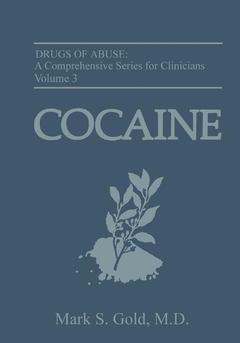Description
Cocaine, Softcover reprint of the original 1st ed. 1993
Drugs of Abuse: A Comprehensive Series for Clinicians Series, Vol. 3
Author: Gold Mark S.
Language: English
Subjects for Cocaine:
Keywords
biology; cocaine; drug; memory; neurobiology; pharmacology; prevention; therapy; treatment
Publication date: 03-2012
248 p. · 14.8x21 cm · Paperback
248 p. · 14.8x21 cm · Paperback
Description
/li>Contents
/li>
For every news story in the popular press detailing the horrors and the violence associated with cocaine, there have been corresponding studies in the medical litera ture shedding new light on our understanding of this most troublesome drug. Our knowledge of addiction, and specifically cocaine addiction, has increased dra matically within the last few years. We stand on the threshold of an exciting new era in addictionology that promises better treatments, improved diagnostic proce dures, and more effective preventative strategies. We must prepare today for the avalanche of exciting dis coveries that will arrive in the coming years. Along with the first two volumes in this series, Marijuana and Alcohol, this book strives to help the general medical community to stay abreast of the latest medical information on addiction, while presenting a fundamental resource on the neurobiology, physiology, epidemiology, history, diagnosis, treatment, and p- v vi PREFACE vention of cocaine abuse. In addition, the comorbidity of cocaine abuse and eating disorders, depression, anx iety, hypertension, and various other disorders is dis cussed in detail. Finally, the last chapter presents new strategies tailored to specific patient groups and aimed at confronting the ever-changing face of drug abuse.
1. Cocaine in the 1990s.- Prevention: The Best Treatment.- The Persistence of Substance Abuse.- The Evolution of Cocaine Trafficking.- Remaining Challenges.- 2. The History of Cocaine.- The Cocaine “Miracle” of the 19th Century.- The First Cocaine “Crash”.- The Decline of Cocaine Use.- The 1960s.- The Evolution of Cocaine Use.- Other Forms of Cocaine.- The Rise of Polydrug Abuse.- The Success of Antidrug Campaigns.- Changes in Youth Attitudes.- Changes in Adult Attitudes.- Remaining Challenges.- The Legalization Debate.- 3. The Neurobiology of Cocaine.- The Role of Reward in Drug Use.- Stimulant Reinforcement.- Serotonin and Other Factors in Stimulant Reward.- Nonpharmacological Factors.- The Physiological Aspects of Drug Memory.- The Effects of Varying Routes of Administration.- The Rewarding Effects of Other Drugs.- Learning as an Outcome of Reinforcement.- Withdrawal.- The Role of Craving in Relapse.- Other Areas of Interest.- Clinical Implications.- 4. The Clinical Manifestations of Cocaine Abuse.- Acute Effects of Cocaine.- Chronic Effects of Cocaine.- Medical Complications of Cocaine Abuse.- The Medical Complications of Polydrug Abuse.- Routes of Administration.- 5. Outpatient Treatment.- Cocaine Treatment Programs.- Group Therapy.- The Role of Twelve-Step (Self-Help) Groups.- Residential Treatment.- Follow-Up Care and Family Involvement.- 6. Inpatient Treatment and Relapse Prevention.- The Benefits of Inpatient Care.- Qualities of an Inpatient Program.- Relapse Prevention.- Outcome of Treatment.- Problems with Cocaine Treatment.- 7. Pharmacological Treatments.- Pharmacological Treatment of Cocaine Craving.- Bromocriptine.- Tricyclic Antidepressants (TCAs).- Carbamazepine.- Buprenorphine.- Naltrexone.- Miscellaneous Agents.- 8. The Role of Drug Testing.-The Evolution of Drug Testing.- The “Demographics” of Drug Testing.- The Most Common Forms of Urinalysis.- Evaluation of Testing Facilities.- 9. Eating Disorders and Substance Abuse.- The Demographics of Eating Disorders.- Theories behind the Comorbidity of Eating Disorders and Substance Abuse.- Common Biological Pathways for Eating Disorders and Substance Abuse.- Treatment Implications.- 10. Physicians, the Elderly, Adolescents, and Substance Abuse.- The Medical Profession.- The Elderly and Substance Abuse.- Adolescents and Substance Abuse.- Multiple Substances of Abuse.
© 2024 LAVOISIER S.A.S.




